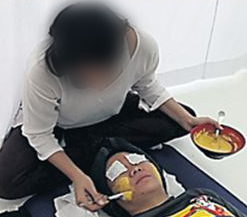SKIN
Skin is the largest organ of the integumentary system which acts as the outer covering of the body andprotects us from microbes and the elements, helps regulate body temperature, damaging sun- light, harmful chemicals and permits the sensations of touch, heat, and cold. It also exudes anti- bacterial substances that prevent infection and manufactures Vitamin D for converting calciun into helathy bones. Skin holds 650 sweat glands, 20 blood vessels, 60,000 melanocytes and more than 1,000 nerve endings.
- Epidermis, the outermost layer of skin, provides a waterproof barrier and creates our skin tone.
- Dermis, beneath the epidermis, contains tough connective tissue, hair follicles, and sweat glands.
- Hypodermis, the deeper subcutaneous tissue is made of fat and connective tissue.
COMPLEMENTORY THERAPY
Ayurveda is an ancient East Indian medicinal science, most of its beauty remedies use food, herbs and spices to help detoxify, tone and enhance the skin. The Facial Detox focuses on the face and neck to release deeply held tension making the skin appear toned and healthy. It also detoxifies and stimulates circulation. The use of Turmeric in the preparation of the mask, works well for acne and eczema. It reduces inflammation and redness, and promotes skin healing. It also helps to exfoliate and moisturize your skin for a firm, tighter skin, giving the face a more youthful appearance.
Ingredients for mask paste:
- 1 tablespoon of Besan powder into a bowl
- 1 teaspoon of mustard oil
- 1 capful of rose water
- ¼ teaspoon of Tumeric powder
- ¼ teaspoon of Sandal paste
- Stir and mix all ingredients in a bowl to form a thick paste
- Add a little water if it is too thick or if paste is not thick enough, add in more Besan powder to thicken it
Other requirements:
- Facial wash; Himalaya Neem face mask; and Cream (prescribed by Doctor)
- Steamer and Vitamin K face detox tablet (as prescribed by Doctor)

Procedure:
- Wash face with facial wash
- Steam face for 5 minutes
- Apply mask paste prepared earlier and leave it to dry for 15 – 20 minutes
- Once dried, wash face and steam again for 5 minutes
- Apply Himalaya Neem face mask and leave it to dry for 15 – 20 minutes
- Wash face once dried and apply face cream (prescribed by Doctor)
- Take Vitamin K face detox tablet (as prescribed by Doctor)
Subtle Point
- Ensure paste prepared is thick enough
- Spread evenly on face and avoid in contact with eyes
Indication
- Acne management
- General Beauty Regime
- Anti-Aging
Contraindication
- Open wound on face
Acknowledgement to:
- CYT / ATTC Students of Union Yoga Ayurveda Singapore
- Swami Vivekananda Yoga Prakashana Trust, Bangalore
Disclaimer
Yoga Ayurveda Therapy is Complementary Medicine and doesn't alternates any conventional treatment.
Yoga-Ayurveda Therapy needs physical assistance which may need physical touch. You can ask teacher or therapist not to give physical touch or assistance and based on whatever you choose, our teacher or therapist will follow the instructions. Any point you want to change the preference, then please inform teacher or therapist and management in writing. You will take responsibility of your decision and will not hold Union Yoga Ayurveda responsible for any kind of damage.
All kind of Yoga Ayurveda teaching and therapy can cause certain injuries and you are accepting those injuries. Signing up for the therapy or yoga courses means that you are aware of the probable injuries.
Union Yoga Ayurveda (Union Centre Pte Ltd) and its staff are not liable or responsible for any injuries caused during the session which are visible or not visible, physical or hormonal or mental. You as client take full responsibility of your own decision and will not claim any kind of compensation in terms of money or any resources for the damage caused because of due process.
Related Topics
- Yoga Therapy & Common Ailments
- Diabetes Mellitus
- Yoga & Glaucoma
- Chronic Myeloid Leukemia
- Gastro-Esophageal Reflux / Gastritis
- High Blood Pressure
- For Anxiety neurosis, Depressions etc
- For Neurological issues
- Cataract and short / long Sightedness
- Scoliosis / Herneated disc / Sciatica
- Menstrual Issues


